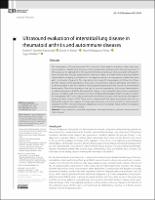| dc.contributor | Hospital General de Granollers |
| dc.contributor.author | Vicente-Rabaneda, Esther F. |
| dc.contributor.author | Bong, David Andrew |
| dc.contributor.author | Möller, Ingrid |
| dc.contributor.author | Busquets Pérez, Noemi |
| dc.date.accessioned | 2022-09-19T11:29:58Z |
| dc.date.available | 2022-09-19T11:29:58Z |
| dc.date.issued | 2022-08-09 |
| dc.identifier.citation | Vicente-Rabaneda EF, Bong DA, Busquets-Pérez N, Möller I. Ultrasound evaluation of interstitial lung disease in rheumatoid arthritis and autoimmune diseases. Eur J Rheumatol. 2022 Aug 9. |
| dc.identifier.issn | 2147-9720 |
| dc.identifier.uri | https://hdl.handle.net/11351/8220 |
| dc.description | Lung ultrasound; Rheumatoid arthritis; Autoimmune diseases |
| dc.description.abstract | The interpretation of lung ultrasound (US) is the result of the analysis of artifacts, rather than exact representations of anatomical structures, which appear when changes in the physical properties of the lung occur. Its application to the study of interstitial lung disease (ILD) associated with autoimmune diseases has aroused great interest in the last 10 years, as evidenced by a growing number of publications studying its usefulness in the diagnostic process, as a prognostic marker, and as an aid in monitoring of patients. The main elements in lung US interpretation in ILD are the B lines and the changes in the pleural line. B lines are vertical artifacts that are generated when there is
a partial decrease in the air content of the lung parenchyma and/or the volume of the interstitial area expands. Pleural line alterations that can be seen are irregularities, thickening, fragmentation, or subpleural nodules. Both the B lines and the changes in the pleural line have shown a significant positive correlation with the evidence on chest computed tomography (high-resolution computed tomography [HRCT]) of ILD associated with autoimmune diseases, with sensitivity and negative predictive values of up to 100%. These results, together with the safety, accessibility, and low cost of lung US, support this imaging technique as a promising screening method for optimizing the indication for HRCT. The role of lung US regarding sensitivity to change needs further investigation
with multicenter prospective studies |
| dc.language.iso | eng |
| dc.publisher | AVES |
| dc.relation.ispartofseries | European journal of rheumatology; |
| dc.rights | Attribution-NonCommercial 4.0 International |
| dc.rights.uri | http://creativecommons.org/licenses/by-nc/4.0/ |
| dc.source | Scientia |
| dc.subject | Pulmons - Ecografia |
| dc.subject | Artritis reumatoide |
| dc.subject | Malalties autoimmunitàries |
| dc.subject.mesh | Lung Diseases, Interstitial |
| dc.subject.mesh | Ultrasonography |
| dc.subject.mesh | Arthritis, Rheumatoid |
| dc.title | Ultrasound evaluation of interstitial lung disease in rheumatoid arthritis and autoimmune diseases |
| dc.type | info:eu-repo/semantics/article |
| dc.identifier.doi | 10.5152/eujrheum.2022.20120 |
| dc.subject.decs | enfermedades pulmonares intersticiales |
| dc.subject.decs | ecografía |
| dc.subject.decs | artritis reumatoide |
| dc.relation.publishversion | https://doi.org/10.5152/eujrheum.2022.20120 |
| dc.type.version | info:eu-repo/semantics/acceptedVersion |
| dc.audience | Professionals |
| dc.contributor.authoraffiliation | [Vicente-Rabaneda EF] Department of Rheumatology, Hospital Universitario de la Princesa, Madrid, Spain. [Bong DA] Faculty of Medicine, University of Barcelona-Bellvitge Campus, Barcelona, Spain. Instituto Poal de Reumatologia, Barcelona, Spain. [Busquets-Pérez N] Department of Rheumatology, Hospital General de Granollers, Granollers, Barcelona, Spain. [Möller I] Instituto Poal de Reumatologia, Barcelona, Spain. University of Barcelona (Anatomy), International University of Catalunya (Medical Image), Barcelona, Spain |
| dc.identifier.pmid | 35943459 |
| dc.rights.accessrights | info:eu-repo/semantics/openAccess |

